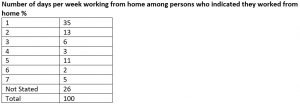//
Introduction
The WDC produced the Policy Briefing e-Working in the Western Region in March 2017, see here. This briefing aimed to quantify the extent of e-working in the Western Region and nationally and set out policy recommendations. Since then e-working or remote working and co-working spaces such as hubs have received a lot of attention, but to what extent is the activity on the increase?
In the Policy briefing, the WDC noted that the extent of e-Working is hard to measure, in part because of the paucity of data, and in part because the practice is sometimes not very visible; it is often in the absence of company policy and at the discretion of local management. Some recent data in relation to official statistics and company practice is presented here.
CSO Pilot for Census 2021
There has been limited official statistics measuring the incidence of working from home. To date the Census has asked the question ‘how you usually travel to work’? with one of the answers being ‘work mainly at or from home’. This is very limited as it only captures those that work from home most of the working week and excludes those who work from home one or two days per week, which some suggest is the most common pattern.
The CSO invited submissions to the consultation on questions for inclusion in Census 2021. In its submission, the WDC advocated for the inclusion of a question to more effectively capture the extent of Working from home/ e-working. Following the consultation exercise and a pilot exercise the CSO have now agreed to include a question measuring the number of days people work from home on a weekly basis in Census 2021. The results of the pilot survey were released earlier this year and they provide an insight into e-working. Some of the findings are highlighted below.
Among those at work, 18% declared they worked from home. The level of non-response among workers was low at 3%. Of those working from home, the breakdown by number of days was as follows:
Working from home 1 day per week was the most popular practice (35%), followed by 2 days a week (13%) and 5 days per week (by 11%). It should be noted over a quarter of those who said they worked from home did not state the number of days. One possibility may be that their pattern changes on a weekly basis.
Profile of those working from home
- The pilot results showed that the percentage of those working from home increased as age increased, peaking at 19.6% of those at work in the age group 45-49. The proportion of home workers decreased among workers in older age groups. Among those in the 45-49 year age group, 32% worked one day from home.
- Approximately 60% of people who work from home were male.
- There were notable differences in the occupation of those who worked from home. e.g. 13.5% of those who worked from home worked in the ‘Science, research, engineering and technology professional’ occupation category.
- In contrast only 0.6% of those who worked from home indicated they were in the ‘Process, plant and machine operatives’ occupation category
- Over half of those who worked in ‘Computer programming, consultancy and information service activities’ indicated that they worked from home. This industry comprised 3% of all workers in the Pilot but 11% of all home workers were in this industry.
- Of those who worked from home, 79% had fixed broadband internet, 18% had mobile broadband internet, and 3% indicated they had no internet connection. It is possible that that much of this 3% do not depend on internet access to conduct their work, for example those engaged in agriculture. See the CSO release here.
The WDC very much welcomes the inclusion by the CSO of the question on working from home in the next Census. This will allow a more thorough analysis of the practice based on comprehensive Census data.
Company Practice- Incidence of e-work in Ireland
Another part of the evidence base is data collected by companies on the extent to which they provide for flexible work practices such as e-working and the extent to which this is practiced by their employees.
IBEC have collected survey data on the extent of e-working for a few years now. Data has been recently published which shows an increasing prevalence of the practice based on a survey of IBEC members. For example,
- In 2018, 37% of IBEC members (152 companies) had a practice of e-Working/ home-working, on one or two days per week basis, up from 30% (110) in 2016.
- In 2018, 7% had a practice of e-Working five days per week, up from 5% in 2016.
- The IBEC survey shows that the likelihood of e-Working among companies increases with company size, so that 54% of companies with 500+ employees cite a practice of e-Working on a 1 or 2 days a week basis.
- There is a slightly higher rate of e-Work among foreign owned compared to Irish owned companies, 40% and 33% respectively, and both these figures are up on two years previously – 34% and 27% respectively.
- Sectorally the highest rates are within the Electronic services sector (69%), followed by the Financial services sector (58%).
- At a regional level IBEC members in the Dublin region have the highest incidence, with almost half (49%) report having an e-working policy of 1-2 days working from home per week. This rate drops to one-third of companies in the Cork region, one-quarter in the Mid-West and South-East and 24% in the West/North West.
This regional variation supports the idea that at least some of the e-working demand and take-up by employers is driven by congestion in larger urban centres.
Demand for e-working/co-working spaces/ Hubs
Another aspect of e-working or remote working is where the worker works from a hub rather than home. The success of initiatives variously called e-working spaces/ co-working spaces/ hubs also suggests e-working is on the increase. Some working spaces are funded by Department of Business, Enterprise and Innovation and some by the Department of Rural and Community Development. The hubs are variously classed as innovation, enterprise or community hubs, and many are focussed on start-ups and incubation spaces as well as providing e-working spaces for individual employees.
The Western Development Commission is coordinating an initiative with the Department of Community and Rural Development (DCRD) called the Atlantic Economic Corridor (AEC) Enterprise Hubs project. This three year project aims to create an interconnected community network from the 101 hubs identified in the AEC region (the region from Donegal to Kerry) along the Western Seaboard.
This week the WDC is convening two workshops, one in Limerick (19th November) and the second in Sligo (Thursday 21st November) aimed at bringing all key stakeholders together to work together to optimise the operation of the hubs and how they can support regional and rural development, e-workers and remote workers throughout the region. For further information see here for more information.
Deirdre Frost





